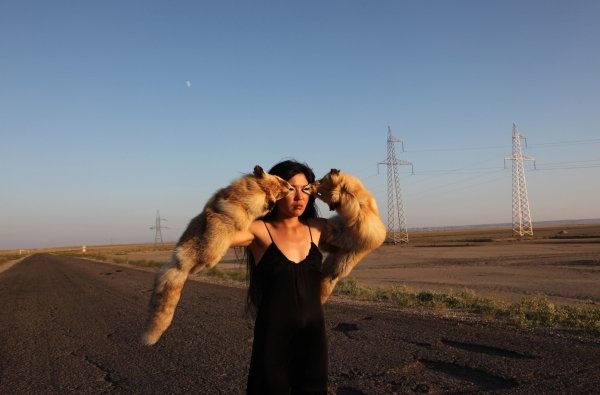Rustam Khalfin and Almagul Menlibayeva
dal 15/7/2010 al 28/8/2010
Segnalato da
15/7/2010
Rustam Khalfin and Almagul Menlibayeva
Museum van Hedendaagse Kunst Antwerpen M HKA, Antwerp
Lonely at the top. Europe at large #6

With the collapse of the USSR, the European horizon in that direction has been limited to Russia. However, we are quite unfamiliar with what is going on in the dynamic Central Asian states and in the old cultural countries in the Caucasus. This season in the galleries of LONELY AT THE TOP we will present artistic positions from these important cultural regions.
Since the collapse of the USSR, the European horizon in that direction has remained limited to Russia. We know very little about what is happening in the dynamic Central Asian states and in the Caucasian countries with ancient cultures. The Russian critic and theorist Viktor Misiano has for several years been working to support the artists of this region, which has resulted in some controversial exhibitions. He selected those artistic points of reference he considered most crucial, which included key works by the artists concerned. These works are shown in ensembles and will ultimately also be incorporated into the museum’s collection.
The sixth and final presentation presents work by Rustam Khalfin (Uzbekistan) and Almagul Menlibayeva (Kazakhstan).
Rustam Khalfin (º1948, Tashkent, Uzbekistan – 2008, Almaty, Kazakstan) is considered a pioneer of Kazakhstan’s contemporary art scene. After graduating from the Moscow Architecture Institute, he moved to St. Petersburg in the 1980s where he became involved in the circle surrounding Vladimir Sterligov – a close associate of Kazimir Malevich. Later on he broke off with their formative traditions and moved towards a more contemporary art practice, introducing performance art in Kazakhstan.
Khalfin employed a variety of subjects in his work, including the history of Central Asia, the pre-Islamic history of Kazakhstan, nomad traditions, perception and the inner workings of mind, and others. The conceptual dimension of his oeuvre has always been complimented by an underlying sensuality. He remains an inspiration for younger Kazakh artists, including Almagul Menlibayeva, whose work M HKA presents together with that of her teacher.
Khalin’s video installation Northern Barbarians (2000) consists of two videos made in collaboration with artist Julia Tikhonova (º1978, Almaty). In Love Races, a couple is making love atop a horse, re-enacting an old ritual of Kazakh nomads.
The video Bride and Groom is about two lovers who, through an old custom, are forbidden to see each other before their wedding day, except through the trellis wall of the yurt. Both videos explore Khalfin’s interest in the physics of the personal perspective related to the notion on Kazakh identity before the subsequent repression of indigenous Central-Asian cultures by the Soviet Union.
The elementary objects installed here are called pulota, referring to a central concept of the artist meaning ‘a void in a fist’. They represent the hollow space within a fist, a fragmentation of the field of vision, a bodily camera obscura. The word itself is a combination of the Russian words pustota (void) and kulak (fist) and refers to nomadic wanderings through one’s inner space, an exploration which occupied Khalfin throughout his professional and personal life.
Almagul Menlibayeva (º1969, Almaty, Kazakhstan)
Currently lives and works in Berlin and Amsterdam. She studied at the Academy of Art and Theatre in Almaty, Kazakhstan, and her work has been the subject of numerous international solo and group exhibitions, such as the Sydney Biennial of Contemporary Art and the Venice Biennale.
In her work Menlibayeva combines an interest in regional traditions with a critique of official identity politics. She bases this criticism on the idea of nomadic pastoralism, the traditional way of life that distinguishes the history and culture of the Central Asian peoples. Most of her works are built on encounters and shifts of images that refer to an array of ethnic, historical and cultural layers of meaning, where the single-dimensional and rational meets the festive, orgiastic and poetic. Her narrative videos and accompanying photographs thus offer a romantic and melancholic reflection on the non-synchronicity of her home country’s development.
‘In my video performances I employ the language of so-called Romantic Punk Shamanism to express my vision and understanding of the surrounding world. Romantic Punk Shamanism is a bearer of an animistic philosophy born in the depth of my culture’s heart that wants to impart its legacy to the globalized technological society’. (Almagul Menlibayeva)
Image: Almagul Menlibayeva, The Observer , 2010 Courtesy of Priska C. Juschka Fine Art
Press contact:
Rita Compère / Kathleen Weyts
T +3 (0)3 609991 or +3 (0)3 608097 pers@muhka.be
MuHKA Museum van Hedendaagse Kunst Antwerpen
Leuvenstraat 32 2000 Antwerp
Hours:
Tue-Wed and Fri-Sun 11:00-18:00
Thu 11:00-21:00
Closed on Mondays
Entrance:
€ 4: -26, 60+, groups of 10 or more
Free: -13
€ 2,50: While the exhibition is being set up on the ground floor, the public may visit the collection for half-price (€ 2.50; € 1.50; free of charge).



